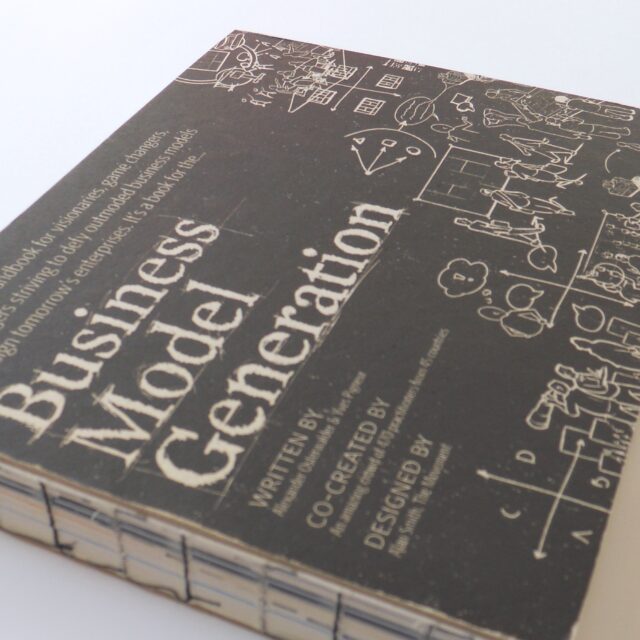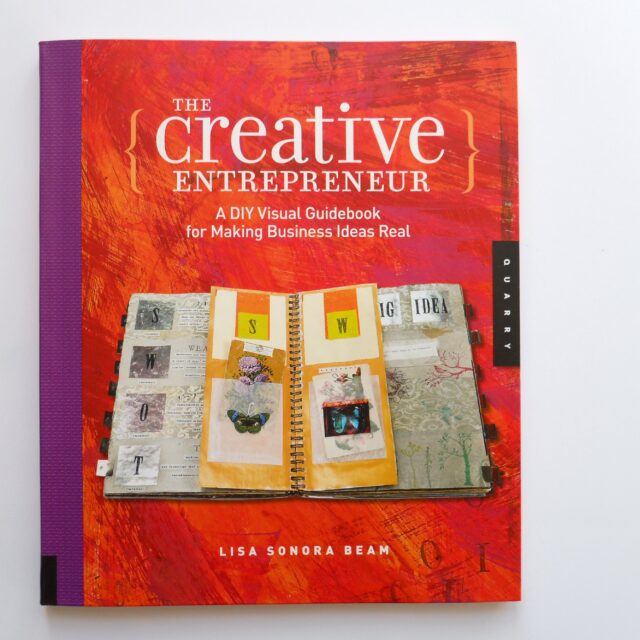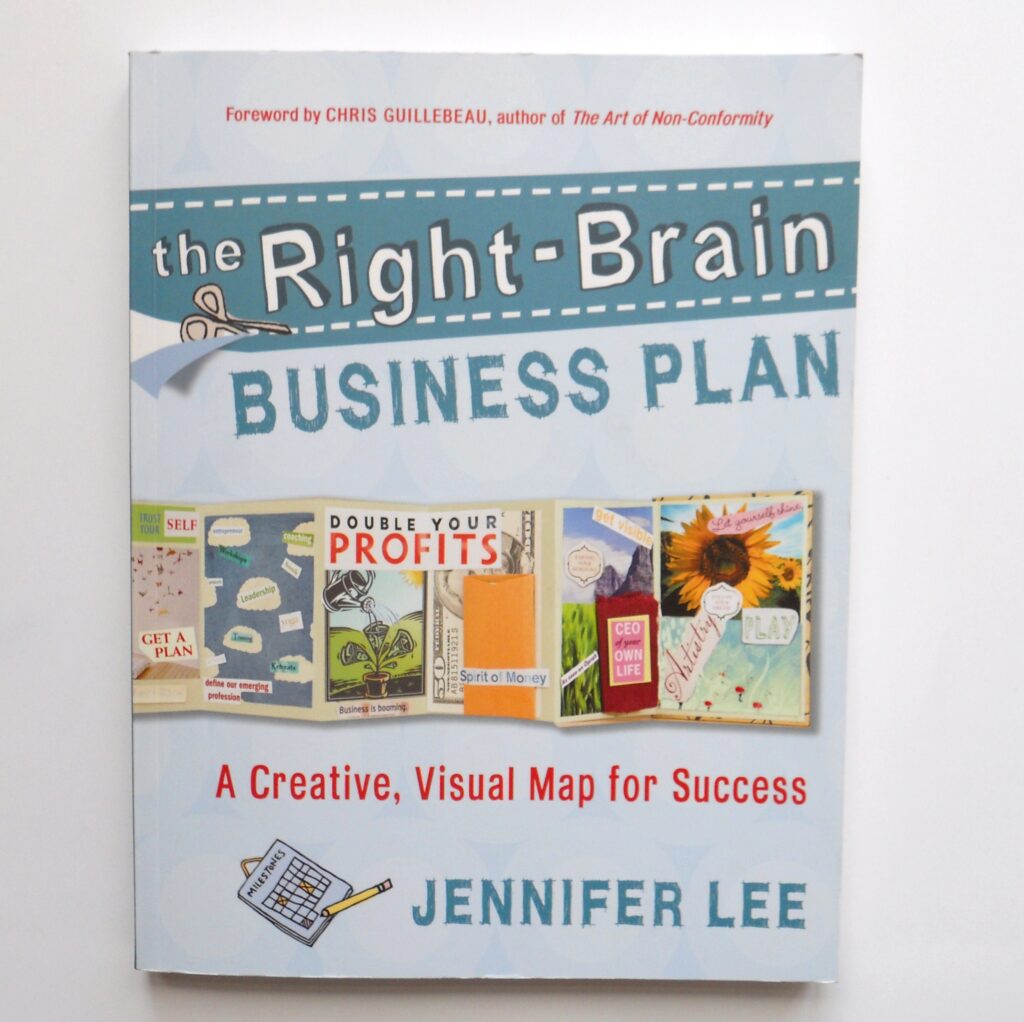Do you believe that ‘business planning’ and ‘creatives’ are completely contradictory and can’t be put in one sentence together? I would disagree with you!
I strongly believe that business planning can be a very creative process … mapping out the journey ahead in a visual way … imagining what you want to do, prototyping your business even … and then checking on a regular basis if you are still on track.
Here is my collection of favourite business planning books for creatives. These are books that I own and have used over the years to help design and craft businesses in a creative way to develop and even stretch their big ideas, to set great goals through a variety of techniques, but most importantly to get them into action and turn their ideas into reality.
I have even added a business planning book for creatives that I have written myself … cheeky!
The selection of books covers everything from ‘the big picture’ thinking to ‘in detail’ planning.
All books are available through our affiliate relationship with Amazon, or you can purchase or order them of course from your local book shops, as they really will appreciate it!
‘Business Model Generation’ by Alexander Osterwalder & Yves Pigneur

Originally published in 2010 through a crowdfunding campaign, Business Model Generation by Alexander Osterwalder and Yves Pigneur, has become a classic in the design-thinking community already.
It was one of the first books to really embrace creating a more visual and interconnected business plan. The big idea is around the Business Model Canvas concept, the interlinking parts of each business.
- Who are your customers?
- What are your key activities?
- What value do you add?
- What communication and sales channels do you use?
- What relationship do you want with your customers?
- What revenue streams are you creating?
- What resources have you got?
- What key partnerships have you got?
- What do you spend your money on?
This book asks some very big questions, rather than just giving answers.
By defining each of these parts in detail it allows you to create a better business model. What makes you unique and stand out, and how will your business operate and make money?
The book offers various design thinking techniques and tools that can help to describe, discuss and design a better business of any type: customer insights, ideation, visual thinking, prototyping, storytelling and scenario building.
There is a brilliant in-depth chapter about SWOT analysis (Strengths, Weaknesses, Opportunities, and Threats). SWOT can be a great tool to evaluate your internal and external forces, but many books don’t go deep enough. This book asks some important questions to help you get deeper into your SWOT. Very useful indeed to identify your strengths and weaknesses.
Finally, the book goes through the process of evaluating existing and new techniques of different business models, and how the Business Model Canvas can be turned into a more formal business plan.
Business Model Generation has helped me:
- To work with clients around how their business works, and what doesn’t work. By looking at the 9 different parts you quickly get a sense of their strengths and weaknesses, and what needs to be developed or communicated better.
- To review big ideas really quickly. The Canvas breaks the various parts of any business down so you can quickly sketch out opportunities and challenges. It’s really helpful for strategic thinking and to become more playful around strategic decisions, especially when you are developing a new business, product or service; or comparing various income-generation ideas.
- To understand what business models actually are, and how the internet is changing the way we do business and how we make money. The ideas in this book were the starting point for developing and testing the business model and income streams for The Design Trust when we first started out.
In 2014 Osterwalder published a more detailed book around the area of clients, marketing and how to create value, called Value Proposition Design. This is a great marketing book if you want to dig deeper into the mindset of your ideal clients, their worries and challenges and how you can create better and more innovative products and services as a result of that knowledge.
‘Design a Better Business’ by Patricia van der Pijl, Justin Lokitz & Lisa Kay Solomon
Design A Better Business is another favourite design-thinking business book of mine, which was strongly influenced by the Business Model Generation. This book really brings together my own experience of how creativity and business thinking can work together through creative tools such as brainstorming, storytelling, and prototyping businesses.
Why don’t more business advisers work together with design companies to create better businesses, and to communicate what they do better? This was a question I had been struggling with for twenty years, and only in the last decade or so have we seen this practice of bringing creatives together with business experts and psychologists through design-thinking.
The book is mainly aimed at business advisers and consultants working with creative businesses, but it could also be really useful for design companies who want to work on a deeper level on understanding their client’s positioning in the market. It’s also a practical starting point for creatives who want to learn more about design thinking techniques and tools.
‘The 7 Habits of Highly Effective People’ by Stephen R. Covey
The 7 Habits of Highly Effective People is a classic in the world of professional self-development.
To be fair this isn’t a business planning book for creatives at all. But it uses some great tools to look at your ‘Big Picture’, to identify your life’s vision or purpose. And especially as so many design and craft businesses are one-person businesses (where you literally are your business) this self-development book can be helpful in planning your future life and business.
I did find the title of the book a bit off-putting, to be honest, and it didn’t sound that relevant to me when I read the book for the first time nearly 20 years ago. However, it really touched me on a deep level when questioning what my purpose and values were in my life and work, what I was really passionate about, and what I really wanted to do with my career and work. I have re-read and re-used parts of the book again over the years, just as a reminder, both for myself but also for my creative business clients.
I recommend The 7 Habits of Highly Effective People strongly if you:
- Are looking for the ‘Big Picture’
- Want to get more focused and add meaning to your life and business
- Need help with (structural) time management or goal setting
- Want to identify what makes you really tick, or if you are stuck or feel lost in a job or career that you don’t enjoy.
This book will challenge you to think BIG and long-term: What legacy do you want to leave behind?
The 7 Habits to create a more purposeful and meaningful life (and business) are:
- Be proactive. Take the initiative and make decisions based on your values and principles. Are you taking responsibility for your behaviour rather than your mood or circumstances?
- Begin with “the end in mind”. Create a clear purpose or mission statement based on the life you want to live, to guide you on a day-to-day basis. This has become one of my favourite time management tools.
- Put first things first. Focus on things that matter most, regardless of them being urgent or not. One of the big mistakes most people make is to focus on what others tell you what to do so you get driven by deadlines and chaos.
- Think “win-win”. This habit is about seeking mutual benefit for all parties, encouraging conflict resolution, and thinking in terms of abundance in opportunities, wealth and resources.
- “Seek first to understand, then to be understood”. When others feel listened to, valued and affirmed, then true communication and relationship building can take place.
- Synergise. This is about creating something bigger than 1 + 1.
- Sharpen the saw. This habit is about taking the time to renew all aspects of ourselves: physical, social/emotional, mental and spiritual to avoid burnout.
I have used this book many times with my business clients, especially when working on:
- Developing a long-term vision or mission statement through the 80th birthday exercise.
- Time management. Anything in your inbox or on your to-do list is either urgent or non-urgent, important or non-important. So you get 4 possibilities: urgent & non-important, urgent & important, non-urgent & important, non-urgent & non-important. Covey’s idea is to set time aside to work on the non-urgent & important quadrant (often things to do with systems or the foundations of your business or life), because if you work on this more ‘strategic to do list’ regularly many things on it will become less urgent.
- Sharpen the saw. Look at all aspects of your life and spend time on activities that give you energy, with people that support you. Many high achieving creatives or entrepreneurs can feel lonely and stressed. Spending some time to rejuvenate are essential to continue to be creative and fulfilled.
Want to learn more about the Important versus Urgent matrix? It’s one of the most useful and practical time management tools I use on a regular basis. Watch my 25min Facebook video on the Important vs Urgent exercise here.
‘The Creative Entrepreneur’ by Lisa Sonora Beam

The Creative Entrepreneur is one of the most beautiful business planning books for creatives I have ever seen!
If you are a creative sole trader or freelancer who wants to be guided through the business planning process in a really high quality, visual and unique way, then this is the right business planning book for you!
This book is published to such high standards that it feels at times more like a museum catalogue than a business book is also great if you are struggling with the idea that you actually can make money from something that you are passionate about and really good at. Or if you know what you want to do, but are self-sabotaging your route to success.
Lisa is a visual artist, as well as a business and marketing strategist, and this book is full of very creative examples of all the different planning tools she uses in her training workshops. Nearly every page has examples with full colour images. Some really stunning visual and imaginary plans and images in here!
The Creative Entrepreneur is a great starting point if the ‘traditional formal written plan’ doesn’t work for you. The exercises and plans created in this book can’t really be shared with the average bank to get you a loan, but they will really help you to identify what you want to do and how to make it happen.
Lisa works a lot with visual journaling whereby you gather ideas and concepts through doodling or images or just a couple of words.
I like her idea of ‘business planning as a journey’, being able to see your progress over time, getting more and more clear about what you really are about and want to do. This kind of circular movement (with getting more and more clarity and focus) reflects much more how business planning really is in practice than this idea that you would flash a good business plan out in a week. Indeed in my experience, it’s more likely that it might take you a while before you really know what your business idea and plan really is.
The Creative Entrepreneur’s main concept is focused around the idea of a mandala and 4 pathways that need to be balanced:
- Heart & Meaning looks at your passions and dreams, creating a purposeful business
- Gifts & Flow looks at your unique talents that contribute to ‘flow’
- Value & Profitability looks at creating a customer-centric business, and how to create and deliver value that people will pay for
- Tools & Skills looks at developing your business and leadership capabilities to achieve the results you want in the first three pathways.
The Creative Entrepreneur also shows the strategic tools of SWOT (Strengths, Weaknesses, Opportunities, Threats) and setting SMART objectives – but does this in a uniquely visual and creative way. Really great to be able to see other creatives’ visual examples too.
I hope this book doesn’t bamboozle you with lovely inspiring images of other people’s careers and businesses or makes you think that your visuals wouldn’t be up to scratch to the standards in this book. It should give you the courage to turn your vague business ideas into images and then into a highly visual plan, which can be highly productive and insightful.
‘The Right-Brain Business Plan’ by Jennifer Lee

This book is ideal if you want a step-by-step guide to creating a formal business plan, but want to start from a more visionary and imaginary way (e.g. use your right brain! The Right Brain Business Plan book goes in-depth into each aspect of running a business, and each aspect of a formal business plan.
It includes the different ‘formal’ business plan elements (executive summary, vision and values, competitor analysis, finance, marketing, management and personnel, operations and action plan) and works with a variety of creative exercises to turn your ideas into a formal business plan.
What is useful about The Right-Brain Business Plan is that after doing the creative exercises and tools, it is only a very small step to actually creating the business plan that your bank manager would be happy to consider.
This business book for creatives shows a wide variety of creative exercises (incl. visual interviews, storytelling, collage) and examples, with great success stories that seem very achievable for most freelancers or sole traders. At the end of each chapter, there is a very useful recap of activities and a checklist covering what you just learnt.
There is a great chapter about growing your creative business and creating a support network so that you don’t have to do it alone. This chapter covers a wide range of solutions: creating your ‘helping-hands-wish-list’, creating your job role and job description, who to hire and what to outsource, getting a mentor or coach, forming strategic alliances and partnerships, assembling a board of advisers, finding an accountability buddy.
The last chapter of the book gives practical tips and tools to turn your goals into reality, how to keep the momentum going, and how to keep your business plan alive on a daily basis.
Some of the wording in the book (‘managing the moola’ instead of money) and the style of the hand-made illustrations might put some people off.
‘THE Diary planner’ and Business handbook by Patricia van den Akker of The Design Trust

Am I allowed to include our own diary planner in this list too? I think I am!
Every autumn since 2016, I have published a planner journal or diary planner, especially for creative product businesses to help them turn their big ideas into smaller, do-able activities. In the last 5 years we have sold more than 6,000 Dream Plan Do books and diary planners to over 34 countries across the world!
I created these specialist creative diary planners based on my experience of 25 years as a creative business adviser, trainer and coach. In one place you find all the tools that I use with my clients to help them turn their big ideas into do-able actions. Starting with the ‘big picture’ thinking around your long-term goals and your purpose and values, to setting annual goals for your finances, marketing and production. Each quarter you will review what is working and what needs work in your business through creative visual exercises as the Wheel of Life and Wheel of Business and thought-provoking questions. Each quarter you have the opportunity to set a new specific 90-day goal and create an action plan to ensure that you will focus on that project and the actions that quarter. Then each month you will have a monthly overview with your goals and actions, and my recommended actions for that specific months too, making the most of your quiet and busy times in your creative business. And each week I give you an action question too.
At the start of the diary planner you will get my time management tips, and a whole range of creative exercises to work on your business and yourself, your marketing and your finances. With specific tips and exercises to plan ahead and turn your business ideas into reality.
Oh, and the best bit? This beautiful 250+ page dairy planner for creatives comes with a 6 hour online training (for free!) with really useful training to plan your big ideas and projects, your finances and marketing.
Check out our diary planners on our website here. They are normally available for pre-launch in mid September and then again from early November – February.
What are your favourite business planning books for creatives? Have you read or used any of the books above? We would love to hear your comments and suggestions below in the comments box.
Share your questions and comments